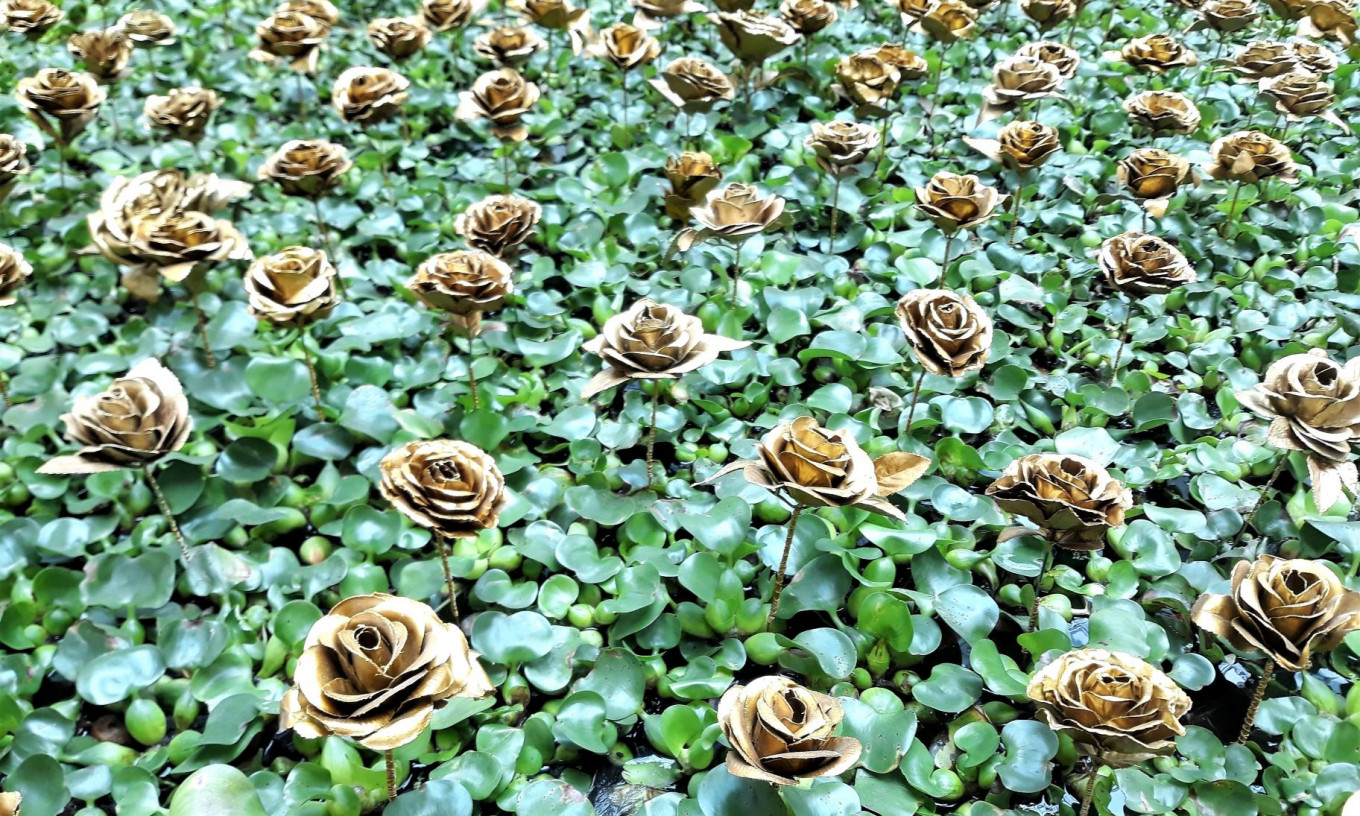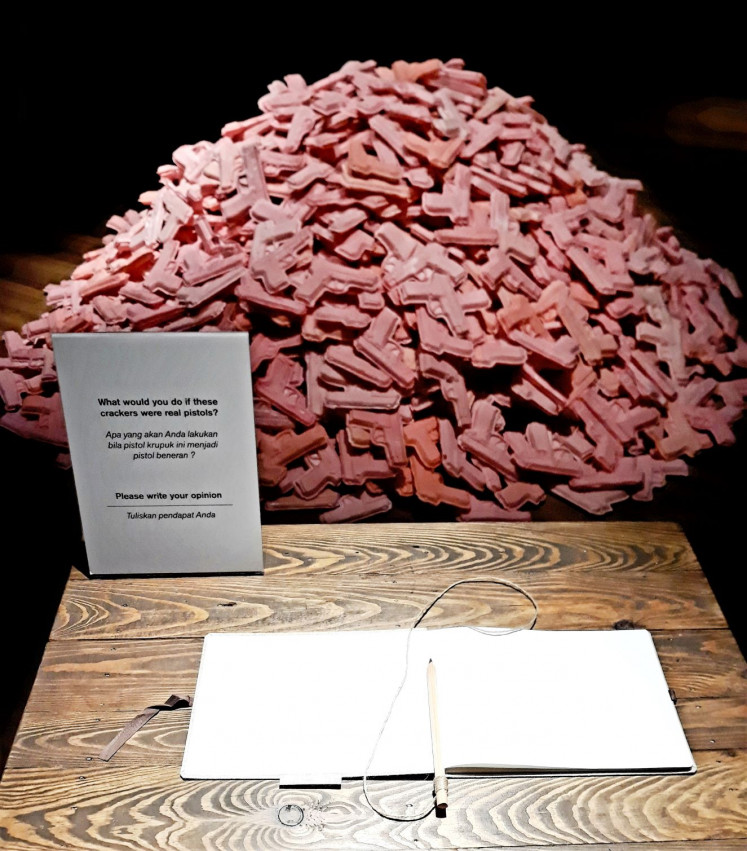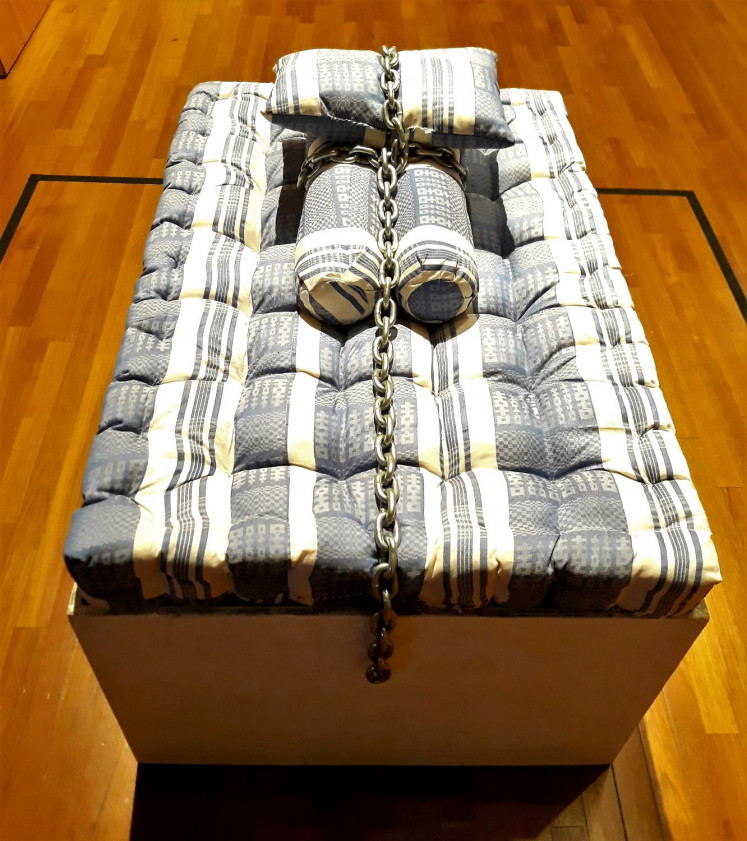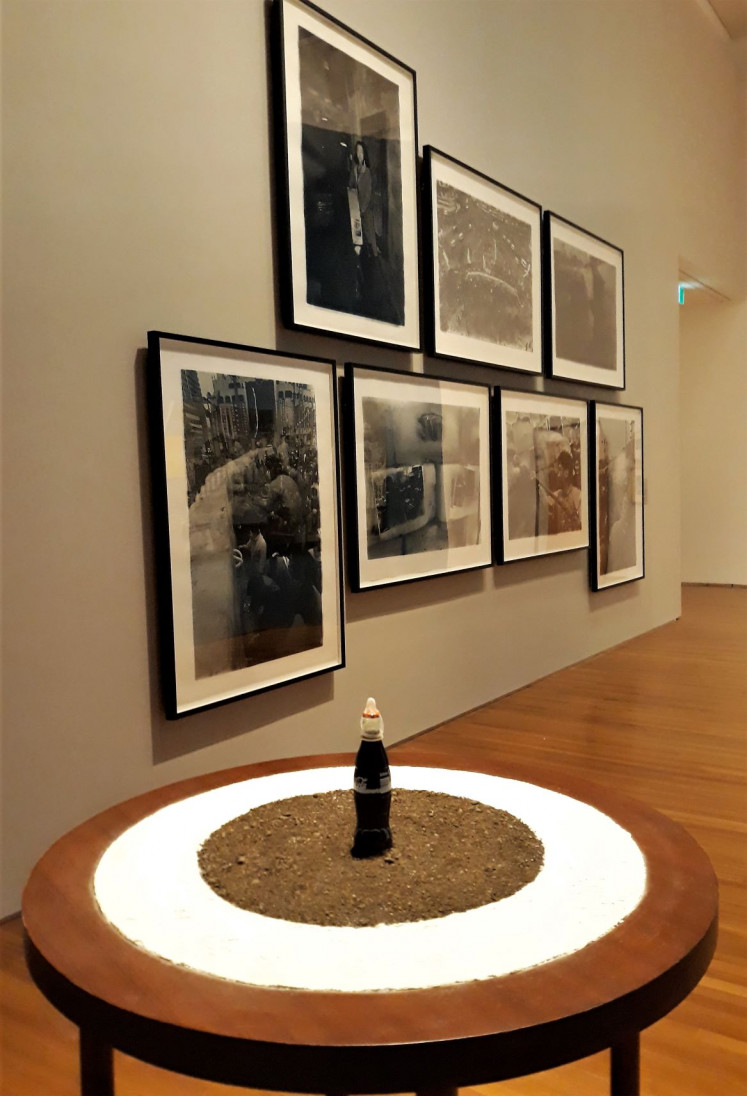Popular Reads
Top Results
Can't find what you're looking for?
View all search resultsPopular Reads
Top Results
Can't find what you're looking for?
View all search resultsAsia’s turbulent times seen through artistic lens
Politically charged artworks by Indonesia’s veteran artists steal the spotlight at National Gallery Singapore’s newly opened exhibition chronicling one of Asia’s most turbulent periods through an artistic lens.
Change text size
Gift Premium Articles
to Anyone
A
pile of pistol-shaped pink crackers was on the floor. Nearby, a wooden desk, blank notebook and a pen were placed next to a note asking people to answer a simple question: “What would you do if these crackers were real pistols?”
The thought-provoking piece, an installation by Indonesian artist FX Harsono, was first created in 1977 and exhibited during the New Arts Movement’s exhibition at the Taman Ismail Marzuki arts center in Jakarta.
'What would you do if these crackers were real pistols?' by FX Harsono. (JP/Stevie Emilia)The 70-year-old artist, a key figure in a movement that emerged in 1975 and sought change through new art forms and contemporary practices, told The Jakarta Post that when creating the work, he did not have someone that he wanted to shoot in mind.
The crackers were even purchased from a trader near his workplace in Jakarta then poured on the gallery’s floor.
The installation was created as part of his series on anti-militarism – a political statement against the authoritarian rule of the New Order regime at that time.
“The question is for the audience, not for me,” he explained through messaging app from Canberra, Australia, where he is taking part in another group exhibition.
“Through the work, I asked audiences to be critical of the power of a repressive military, not about shooting someone,” he added. “I asked the audience to write down what they thought about guns, the military and power.”
At that first exhibition, he said some 90 percent of the viewers left critical notes against the government.
Harsono said he was fully aware of the risks of displaying the installation during its first exhibition but considered himself lucky as the government at that time did not understand much about art, from its metaphors to symbols.
“Moreover, the government at the time did not consider art as something that could not trigger social movement as the exhibition [was held] inside a building, with a limited audience,” Harsono said.
Thought-provoking: FX Harsono's work "The Relaxed Chain" symbolizes oppression during the New Order rule, (JP/Stevie Emilia)Another piece of his currently displayed at the Singapore exhibition, titled The Relaxed Chain, is no less provocative, showcasing a blue mattress that is being gently embraced by steel chains.
Through the work, the artist tried to bring attention to oppression during the New Order rule, which infiltrated every facet of life, even in the most intimate spaces.
“The comfort of the mattress combined with the grip of the chains suggests a society enjoying higher living standards and industrialization brought about by a strong centralized government while being imprisoned by the clampdown of freedom of expression and political participation.”
Harsono’s installations are among 142 artworks by more than 100 artists from 12 countries in Asia on display at National Gallery Singapore’s latest exhibition, "Awakenings: Art in Society in Asia 1960s-1990s".
The exhibition, which runs until Sept. 15, is in its final stop following its successful showings in Japan and Korea. It is jointly organized by the National Gallery Singapore, Museum of Modern Art Tokyo, Museum of Modern and Contemporary Art Korea and the Japan Foundation Asia Center.
The period between the 1960s and1990s was chosen for the exhibition as it marked a critical turning point in Asia’s post-war history, which was characterized by ideological confrontations, a rise in nationalism, rapid modernization and a wave of democratic movements across the region.
Despite the turbulence, the period also witnessed the birth of a multitude of experimental art practices as artists and even the wider public were awakened to the liberating power of art to shape and affirm their identities.
Curator Adele Tan said the exhibition emphasizes how artists questioned conventions and challenged those around them to assume new positions of criticality in society.
“As we can see, such social movements and concerns continue to be relevant today,” she said.
The showcase invites audiences to reexamine their understanding of Asia over the three decades, which collectively saw the reevaluation of politics, society, economics and culture.
At the same time, the viewers are expected to reflect on the role that art continues to play as an expressive tool to bring important issues to the fore.
Addiction: "Sacred Coke" by Indonesian veteran artist Arahmaiani Feisal criticizes consumptive behavior born out of capitalism. (JP/Stevie Emilia)At the exhibition, Sacred Coke by Indonesia’s veteran artist Arahmaiani Feisal shed light on globalization and its connection to American imperialism in her home country.
In the work, a condom is placed upon a Coca-Cola bottle on a table covered by circles of soil and talcum powder, which alludes to cocaine, also known as coke.
Arahmaiani has remade this work over the years and the exhibited version was reproduced from a 1995 piece and was featured in the Contemporary Art from Non-Aligned Countries exhibition in Jakarta.
The artist told the Post from Germany, where she is currently teaching a summer semester at the Passau University’s Southeast Asia department, that the white powder is used as a symbol of capitalism.
Coca-Cola itself, she said, is an American product that could be found everywhere, even remote villages in Indonesia.
“Coca-Cola is not even a healthy drink and tends to make people sick if consumed too much – just like capitalism,” Arahmaiani said.
While the condom represents the need to prevent the spread of capitalism, she said the white powder signifies addiction over consumerism culture.
“This artwork criticizes consumptive behavior that is born out of a capitalist economic system, which I find to be unhealthy and something we should watch for,” said Arahmaiani.
Singapore’s exhibition also features other works by Indonesian artists, including S. Priyanto’s wall drawing Topi Made in France, created in 1976 to challenge the conservative conventions of fine art limited to painting and sculpture; and Dede Eri Supria, whose painting Labyrinth highlights the interconnectedness of contemporary social issues in Indonesia, such as urban poverty, environmental destruction and consumerism.
Artist and art critic Jim Supangkat’s Ken Dedes, a piece depicting a legendary queen considered as the embodiment of perfect beauty in Javanese tradition, is also on display at the exhibition – but in an intriguing manner. Ken Dedes is shown as a Buddhist statue from the chest up and a suggestively posing woman in partially unzipped jeans from the chest down in a way to illustrate a clash between tradition and contemporary culture.
Indonesian artist Siti Adiyati was also commissioned by the Gallery to remake her piece, Eceng Gondok Berbunga Emas (Water Hyacinth with Golden Roses), for the exhibition.
The installation, which was first shown in 1979 during the New Arts Movement exhibition, displays a pool of water hyacinths – a weed that grows on water surfaces and hampers the flow of rivers and is often used as animal feed – intermingles in deliberate contrast with hundreds of seemingly majestic gold-coated plastic roses.
Tan said the work was displayed at the Jakarta Biennale in 2017 but the Gallery asked her to remake the piece to fit the space for the current exhibition.
Through the work, Siti offers a powerful critic against the euphoria of consumerism under former president Soeharto’s New Order government.“It is just an illusion symbolized by the golden rose in the sea of absolute poverty that the eceng gondok [water hyacinth] represents.”














